Auto2D® Gel Electrophoresis Device
How does 2-D gel electrophoresis work? One-dimensional protein gel electrophoresis techniques such as SDS-PAGE are routinely performed in the lab, these methods offer low separation capability. Two-dimensional gel electrophoresis (2-DE) separates proteins in complex samples by pI value and molecular weight, enabling the direct comparison of hundreds or thousands of proteins simultaneously with high resolution. When paired with analytical software, immunodetection, or mass spectrometry techniques, 2-DE provides a powerful tool that aids in protein identification and other proteomic analyses. For additional resources and products, please visit our Protein Electrophoresis and Western Blotting page.
Section Overview
- How Do You Run a 2-D Gel Using the Auto2D® 2-D Electrophoresis Device?
- Why Do We Use 2-D Gel Electrophoresis?
- Auto2D® 2-D Gel Electrophoresis for Food Allergy Applications
- Auto2D® System for Anti-HCP Antibody Validation for ELISA and Other Immunoassays
- Auto2D® System for Antigen Profiling
- Auto2D® System for Regulatory Compliance
- TotalLab Software Enables Enhanced 2-DE
Fully Automated 2-D Gel Electrophoresis
Two-dimensional gel electrophoresis has generally been regarded as difficult to perform and time-consuming, requiring advanced user training while offering low reproducibility and high inter-operator variability. The Auto2D® system fully automates two-dimensional gel electrophoresis. The applied sample enters the first-dimension gel passively, separating proteins by their isoelectric points. After equilibration, the first-dimension gel is set onto a horizontal SDS-PAGE gel, which resolves proteins by molecular weight. The Auto2D® 2-D Electrophoresis Device is user-friendly and enables two-dimensional electrophoresis in 1-2 hours for faster, more reproducible results. Additional features and benefits of the Auto2D® 2-D Electrophoresis Device include:
- Easy to use, with no advanced training required
- Quick workflow implementation for reduced lab downtime
- Decreased inter-operator variability and higher reproducibility
- IQ/OQ support for GMP compliance
HOW DO YOU RUN A 2-D GEL USING THE Auto2D® 2-D ELECTROPHORESIS DEVICE?
The Auto2D® 2-D Electrophoresis Device fully automates two-dimensional gel electrophoresis, simplifying protein analysis and providing more consistent, reproducible results that are user-independent. The efficient engineering of the Auto2D® system significantly reduces the amount of time spent during sample loading, isoelectric focusing, equilibration, and SDS-PAGE from 4-24 hours to only 1-2 hours. This makes the Auto2D® device unique compared to other semi-automated 2-DE systems on the market.

Figure 1.Two-dimensional gel electrophoresis workflow and the steps that are automated by the Auto2D® device.
Why Do We Use 2-D Gel Electrophoresis?
The Auto2D® 2-D Electrophoresis Device has been proven in numerous applications. Examples of suitable use cases include differential protein expression analysis in cancer research and the elucidation of disease mechanisms. Additional applications include the use for separating purified proteins for crystallization or post-translational modification analysis and 2-D western blotting in research areas such as allergy research or cell signaling pathway analysis.
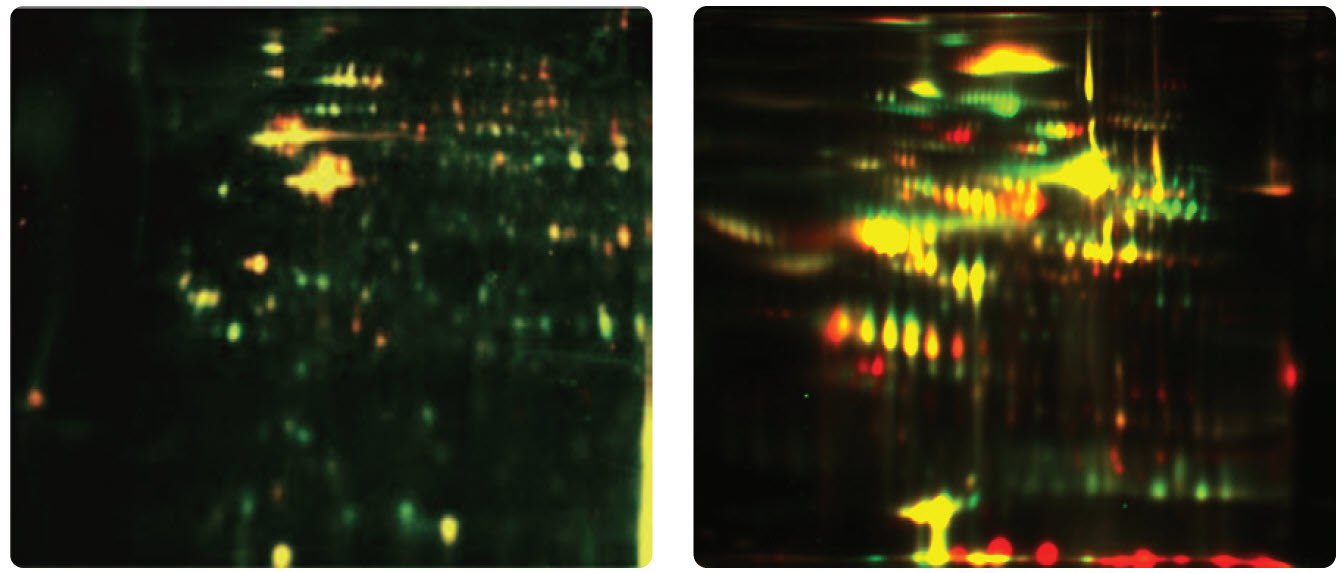
Figure 2.Left: Differential protein expression analysis in cultured cells for cancer biomarker research. Green represents more abundant proteins in normal cells. Red represents cancer-specific protein spots. Yellow represents the overlap in protein expression. Right: Differential protein expression in plasma samples.
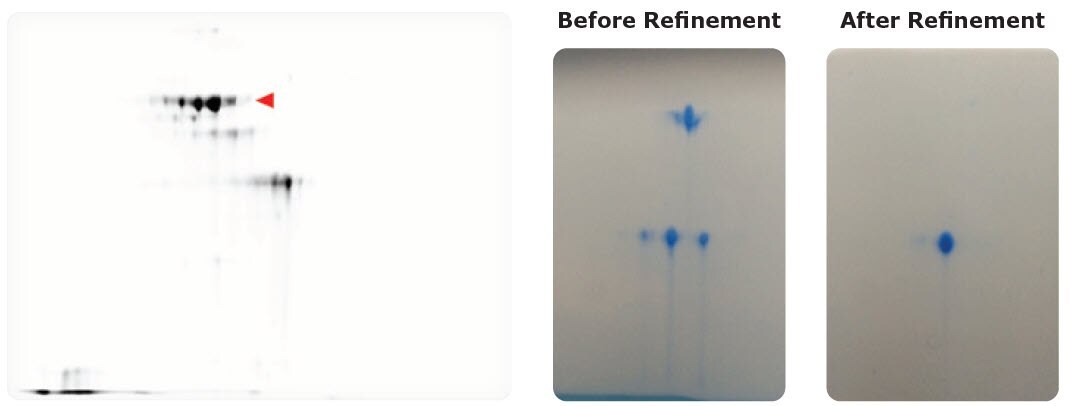
Figure 3.Left: Assessing microheterogeneities in therapeutic antibody drug products. Red triangle indicates spots for target antibody; lower spots are antibody missing regions. Right: Protein analysis before and after purification. 2-DE can be used to check whether the sample is homogeneous for crystallization and X-ray structural analysis.
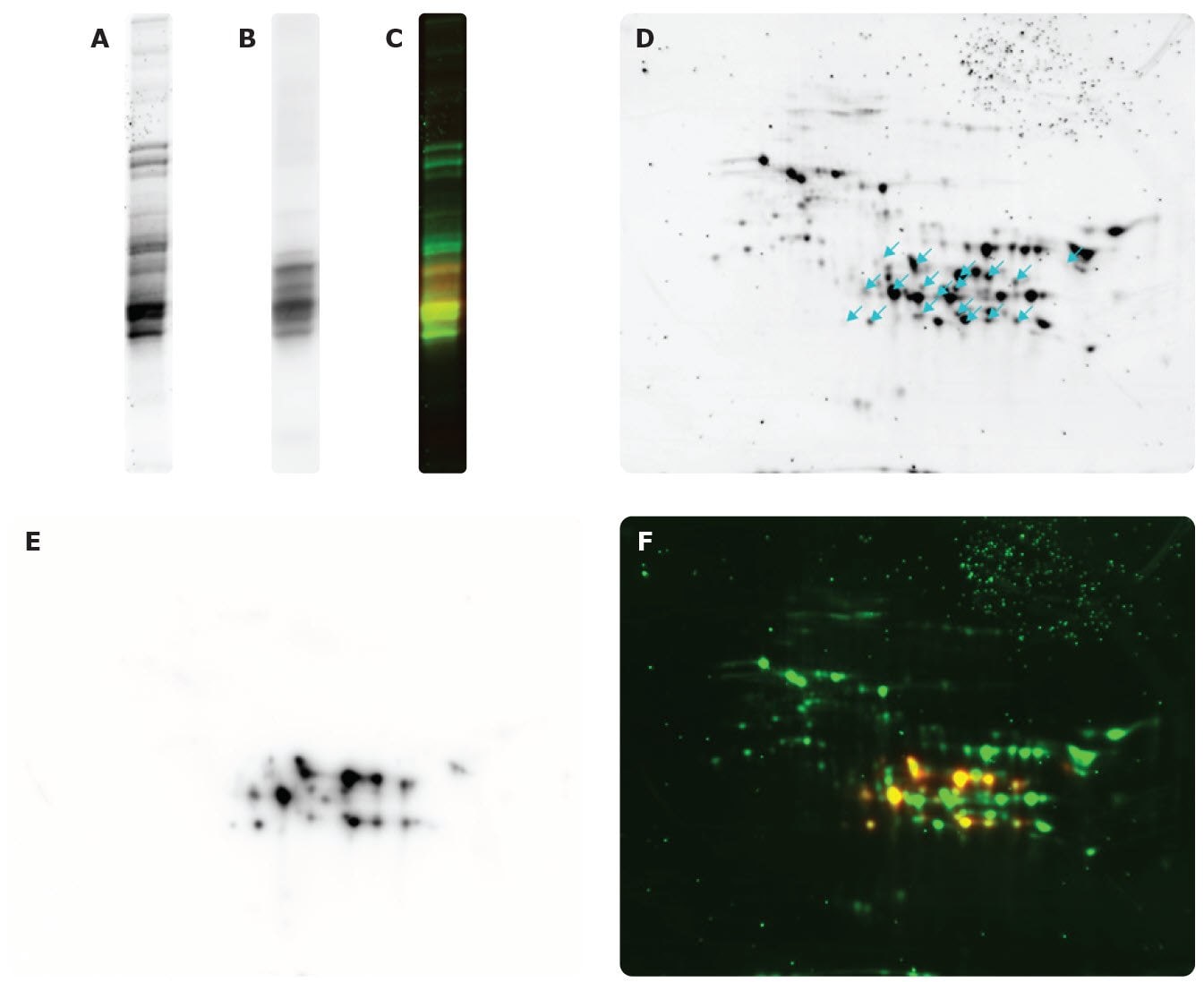
Figure 4.Flour extract proteins (detected by SYPRO Ruby) by SDS-PAGE (A), WB: Anti-Gliadin antibody by SDS-PAGE (B), and merge by SDS-PAGE (C). Flour extract proteins (detected by SYPRO Ruby), arrows indicate spots detected by Anti-Gliadin antibody (D). WB using Anti-Gliadin antibody (E), and merge (F).
Auto2D® 2-D Gel Electrophoresis for Food Allergy Applications
Given the large and growing number of people who suffer from allergies worldwide, it is increasingly important to detect and identify allergens, particularly in food sources. Two-dimensional gel electrophoresis (2D-E) is traditionally used for high-resolution protein separation necessary for the immunodetection of allergenic proteins. However, this traditional separation process is often time-consuming and technically challenging. Our Auto2D® system enables fully automated 2-D electrophoresis in 1-2 hours with quick and reliable results. Here we show that our Auto2D® system is suitable for identifying allergenic proteins from multiple different sources.
Allergies are a common worldwide health issue, with the three major sources of allergens including food (estimated to affect 4% of the world population), pharmaceutical drugs (estimated 10% of the population), and plant pollen (estimated 10-30% of the population and rising) 1-3. Allergic reactions occur through an IgE-mediated immunological response and have traditionally been tested through a skin prick test; however, allergen testing, and diagnostics can also be achieved through molecular approaches 1. The radioallergosorbent test (RAST) and the enzyme-linked immunosorbent assay (ELISA) are two methods used to detect and quantify IgE against specific allergens. Since RAST and ELISA do not include a protein separation step, cross-reactivity between antibodies and food matrix components can cause false-positive results in some instances 1.
Gel electrophoresis is a common and widely used protein separation method. While standard one-dimensional gel electrophoresis separates proteins based on their molecular weight, two-dimensional gel electrophoresis provides higher resolution by separating proteins based on isoelectric point (pI). This increased resolution allows researchers to distinguish between proteins that are close in molecular weight, particularly in the case of isoforms that may have differing allergenicity. The 2D gel electrophoresis technique also has low technical variability, making it a good option for research that has human health implications, such as allergen identification 4.
2-D Gel Electrophoresis for Food Allergy Immunodetection
The 2D gel electrophoresis technique and subsequent immunodetection has been used to identify a variety of allergenic proteins from diverse sources. Plant pollen researchers have used this technique to identify novel IgE binding proteins from red oak pollen as well as to confirm clinically relevant allergens in a natural grass extract, including multiple isoforms of one allergenic protein 5,6. 2D gel electrophoresis was used in a deep dive investigation of the major peanut allergen families, comparing different peanut strains, and has also been used to confirm no differences in allergens between natural and genetically modified soybeans 7,8.
Here, we demonstrate the utility of the Auto2D® gel electrophoresis system in detecting allergens from four food sources: three plants (soybean, walnut, and buckwheat) and one animal source (salmon roe). Additionally, our system was successfully used to identify specific allergens following immunodetection using patient serum. We used the Auto2D® system to resolve single bands from SDS-PAGE into multiple distinct protein spots corresponding with major known allergens in the soybean and salmon roe samples. These results suggest that the Auto2D® gel electrophoresis system can be used for allergen identification, reducing both time and necessary technical expertise while still providing high-quality, reliable results.
Auto2D® 2-D for Food Allergy Applications Results
Soybean extract was obtained by soaking 2.5 g of commercially available soybeans in 25 mL of distilled water overnight, crushing them with a mill, and squeezing them with gauze. The protein concentration was similar to soy milk (approx. 30 µg/μL). Then, 30 μg of sample was subjected to analysis using the Auto2D® system and 0.5 μL to conventional SDS-PAGE. For 2D-E with the Auto2D® system, IEF Chip pH3-10NL was selected as the 1st-Dimension and PAGE Chip 12.5% as the 2nd-Dimension. The sample was run using the standard program (pH3-10NL M). After electrophoresis, proteins in 1D SDS-PAGE and Auto2D® gels were stained with Coomassie Brilliant Blue Stain (CBB). A separate sample was run on our Auto2D® device and was transferred to an Immobilon® P blotting membrane via semi-dry blotting. For immunodetection, the blotting membrane was blocked with 5% NFDM in PBS-T. After blocking, soybean allergic patient serum (International Bioscience, Inc.) was diluted 20x in blocking solution, added to the membrane, and incubated with gentle agitation. After washing with PBS-T, the membrane was reacted with HRP-conjugated secondary antibody diluted in blocking solution followed by standard chemiluminescence detection.

Figure 5.2D-E separation of soybean extract and immunodetection using patient serum. Soybean protein extract was separated by SDS-PAGE (A: 15 ug) and the Auto2D® system (B, C: 30 ug) using IEF Chip: pH3-10NL, PAGE Chip: 12.5% and the Tris-Glycine Reagent Kit. Whole protein in the gel was stained with CBB (A-1, B). Immunodetection was performed using soybean-allergic patient serum (A-2, C). Corresponding to the main band in SDS-PAGE, spots considered to be Gly m 6, a major soybean allergen component were detected around 18kDa (red arrows).
Each additional antigen sample was prepared under the following conditions respectively. Buckwheat flour was defatted with diethyl ether, treated with coca buffer (85 mM NaCl, 32.7 mM NaHCO3, 42.5 mM phenol), and dialyzed with PBS. To remove salts and ionic impurities that can affect the 1st-D IEF process, buckwheat extract was further processed using a protein precipitation kit (ProteoExtract® kits). Walnuts were crushed with a mortar and protein extraction was performed using the Mammalian Cell Lysis Kit (MCL1, Sigma). Salmon roe tissue was homogenized in 1M KCl-PBS. Walnut and salmon roe extracts were desalted using gel-filtration spin columns. Depending on the desalting method, protein samples were dissolved in or exchanged to rehydration solution (8M urea, 2M thiourea, 4% CHAPS, 50mM DTT, 0.02% ampholyte).
Protein quantitation for each prepared sample was performed using BCA or Bradford protein assay. Protein separation was performed using the pre-installed standard Auto2D® program (“pH3-10NL M” recipe), or by conventional SDS-PAGE. IEF Chip pH3-10NL and PAGE Chip 12.5% were selected as the 1st-D and 2nd-D gel chip to cover the widest possible separation range. After electrophoresis, separated proteins in Auto2D® gels were stained with Coomassie ReadyBlue™ stain or SYPRO® Ruby Gel stain. Separately prepared Auto2D® gels for immunodetection were removed from the chip and transferred to an Immobilon®-P blotting membrane using a wet transfer device (KS8452, Oriental instrument). PVDF membranes with transferred proteins were blocked with SuperBlock™ Blocking Buffer in PBS for 1hr. Patient sera were diluted 30-fold with PBS containing 0.1% BRIJ and allowed to react with the membranes while shaking at 4°C overnight. After washing the membrane with the above dilution buffer, alkaline phosphatase (AP) conjugated Anti-human IgE Ab (SeraCare) diluted 2,000-fold was applied as a secondary Ab and incubated at room temperature for 3hrs. After washing, the membrane was equilibrated in AP reaction buffer (100 mM Tris-HCl buffer pH 9.5 containing 100 mM NaCl and 5 mM MgCl2) and reacted with 1-component type of BCIP/NBT substrate (SeraCare) for chromogenic detection of the target proteins.

Figure 6.2D-E separation of walnut protein extract and immunodetection with allergic patient serum. Walnut protein extract was desalted in a gel-filtration spin column, equilibrated with rehydration solution, and separated by SDS-PAGE (A) and the Auto2D® system (B, C, D: 10 ug) using IEF Chip: pH3-10NL, PAGE Chip: 12.5% and Tris-Glycine Reagent Kit. Whole protein in walnut extract is visualized by amido black on membrane (A), and by SYPRO® Ruby gel stain (B), immunodetection using patient serum (C) and non-allergic serum as a negative control (D).

Figure 7.Immunodetection with buckwheat-allergic patient serum. Buckwheat protein extract treated with the ProteoExtract® precipitation kit was dissolved in rehydration solution and separated by SDS-PAGE (A) and the Auto2D® system (B, C, D: 10 ug) using IEF Chip: pH3-10NL, PAGE Chip: 12.5% and the Tris-Glycine Reagent Kit. Whole protein in buckwheat extract is visualized by Amido Black on membrane (A-1) or SYPRO® Ruby reagent in gel (B). Immunodetection using patient serum (A-2 and C) and non-allergic serum as a negative control (A-3 and D).

Figure 8.Separation and immunodetection of allergic components by probing with salmon roe-allergic patient serum. Salmon roe protein extract was desalted in a gel-filtration spin column, equilibrated with rehydration solution and separated by SDS-PAGE (A) and the Auto2D® system (B, C, D) using IEF Chip: pH3-10NL, PAGE Chip: 12.5%, and the Tris-Glycine Reagent Kit. Whole protein in salmon roe extract is visualized by Amido Black on membrane (A-1) or ReadyBlueTM CBB staining reagent in gel (B, 35 ug). Immunodetection using patient serum (A-2 and C, 10 ug) and non-allergic serum as a negative control (A-3 and D: 10 ug). Spots (red arrows) around 15 to 20 kDa are considered major allergens of salmon roe β’-component, which is a 35 kDa-vitellogenin-fragment consisting of two subunits.
The Western blot images were compared with total protein detection to identify the protein spots that reacted with IgE in allergic sera. To identify the allergenic component, overlapped spots are usually excised from the gel, enzymatically in-gel digested into peptide fragments, and the fragments are analyzed using mass spectral analysis. 2D-E was able to demonstrate superior resolution, showing the presence of multiple proteins in what appeared to be a single band in 1D-E. These data suggest that IgE reacting proteins can be separated and identified in fewer steps by 2D-immunodetection using allergic sera, more easily enabling the identification of causative molecules by mass spectral analysis.
Auto2d® 2-D for Food Allergy Applications Discussion
Two-dimensional gel electrophoresis is a common protein separation technique used in the detection and identification of allergenic proteins. The Auto2D® system is designed to reduce the time and technical expertise necessary to obtain high-quality results from this technique. Here, we confirm the utility of the Auto2D® system for allergy research by detecting allergens in protein samples from four food sources. Additionally, we were able to resolve a known, major allergen in each of the soybean and salmon roe samples from a single band in one-dimensional SDS-PAGE into multiple, distinct spots using the Auto2D® system. In the soybean sample, we resolved three spots from the 18kDa band that corresponds to the basic subunit of Gly m 6 (glycinin), a major, known allergenic protein 9. In the salmon roe sample, we resolved multiple spots from the 16-18kDa band that corresponds with the two subunits of β’-component (vitellogenin), also a major, known allergenic protein 10. Overall, these results suggest that the Auto2D® system can be used effectively as a fast, reliable alternative to traditional 2D gel electrophoresis for allergen immunodetection.
Acknowledgements:
We gratefully acknowledge Prof. Tatsuya Moriyama (Kindai University, Faculty of Agriculture) for providing soybean data and Prof. Yasuto Kondo (Fujita Health University Bantane Hospital) for providing walnut, buckwheat, and salmon roe data.
Residual HCP Measurement in Biopharmaceuticals
2-D gel electrophoresis is also suitable for contaminating host cell protein (HCP) analysis in therapeutic protein and antibody bioprocessing. Residual HCP impurities introduced during biologics manufacturing processes can trigger immunogenic responses in patients and reduce drug efficacy. Regulatory compliance calls for the monitoring and removal of HCPs to acceptably low levels to ensure safety. Pharmacopoeias in Japan, Europe, and the United States have published guidelines for the development and validation of HCP assays for biopharmaceutical product manufacturing.
To meet compliance, HCP assays must be methodically developed with rigorous qualification of all assay components. For antibody validation, two dimensional polyacrylamide gel electrophoresis (2D-PAGE) is required to ensure comprehensive HCP coverage. Gel electrophoresis methods including 2D-PAGE are also advised for the characterization of antigens used as calibration standards or immunogens for polyclonal antibody production. The Auto2D® 2-D Electrophoresis Device eliminates the need for advanced user training, facilitating implementation into bioprocess workflows to meet compliance with industry standards.
Auto2D® Systems for Anti-HCP Antibody Validation for ELISA and Other Immunoassays
ELISAs are the most common assay format for HCP analysis. This immunoassay method relies on polyclonal antibodies that recognize residual HCPs with broad range coverage. Japanese and European Pharmacopoeia specify the use of 2-D gel electrophoresis followed by Western blot analysis (2-D Western blotting) to evaluate HCP antibody coverage. U.S. Pharmacopoeia specifies the use of 2-D Western blotting or immunoaffinity purification followed by gel electrophoresis to evaluate antibody coverage.
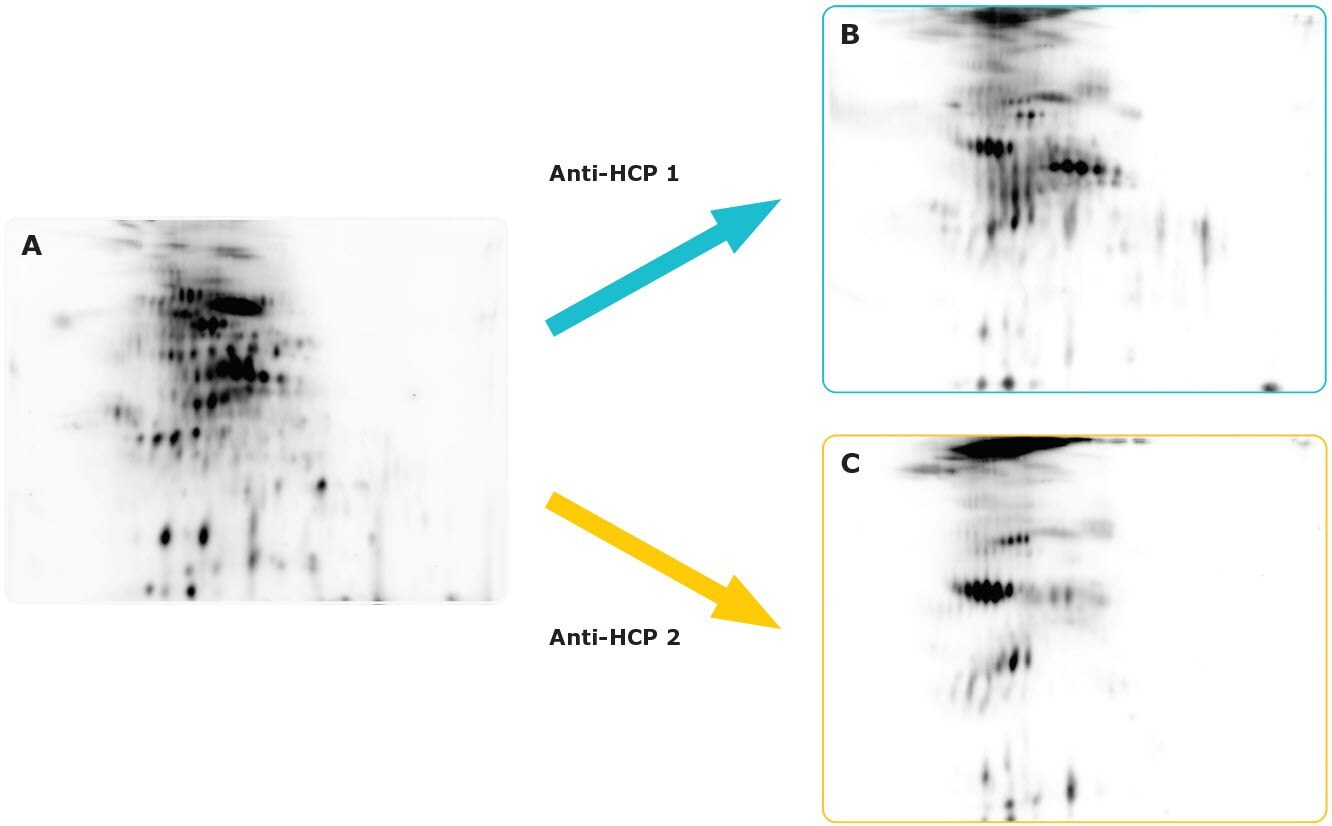
Figure 9.20 μg of Cy3-labeled CHO HCP antigen from a commercial source was separated by 2-D gel electrophoresis on the Auto2D® system using a pH 3-10 IEF chip and 12.5% PAGE chip (A). Proteins were then transferred to membranes and analyzed by Western blotting using two different anti-HCP antibodies (B, C). Data indicate that anti-HCP antibody 1 has broader coverage of host cell proteins, compared to anti-HCP antibody 2.
High Reproducibility of the Auto2D® System
Consistent, reproducible processes are essential in biologics manufacturing and quality control. In addition to faster results and higher throughput, the fully automated Auto2D® gel electrophoresis system eliminates day-to-day and inter-operator variability in 2D-PAGE and 2D-DIGE methods, offering significantly better reproducibility for more reliable results.
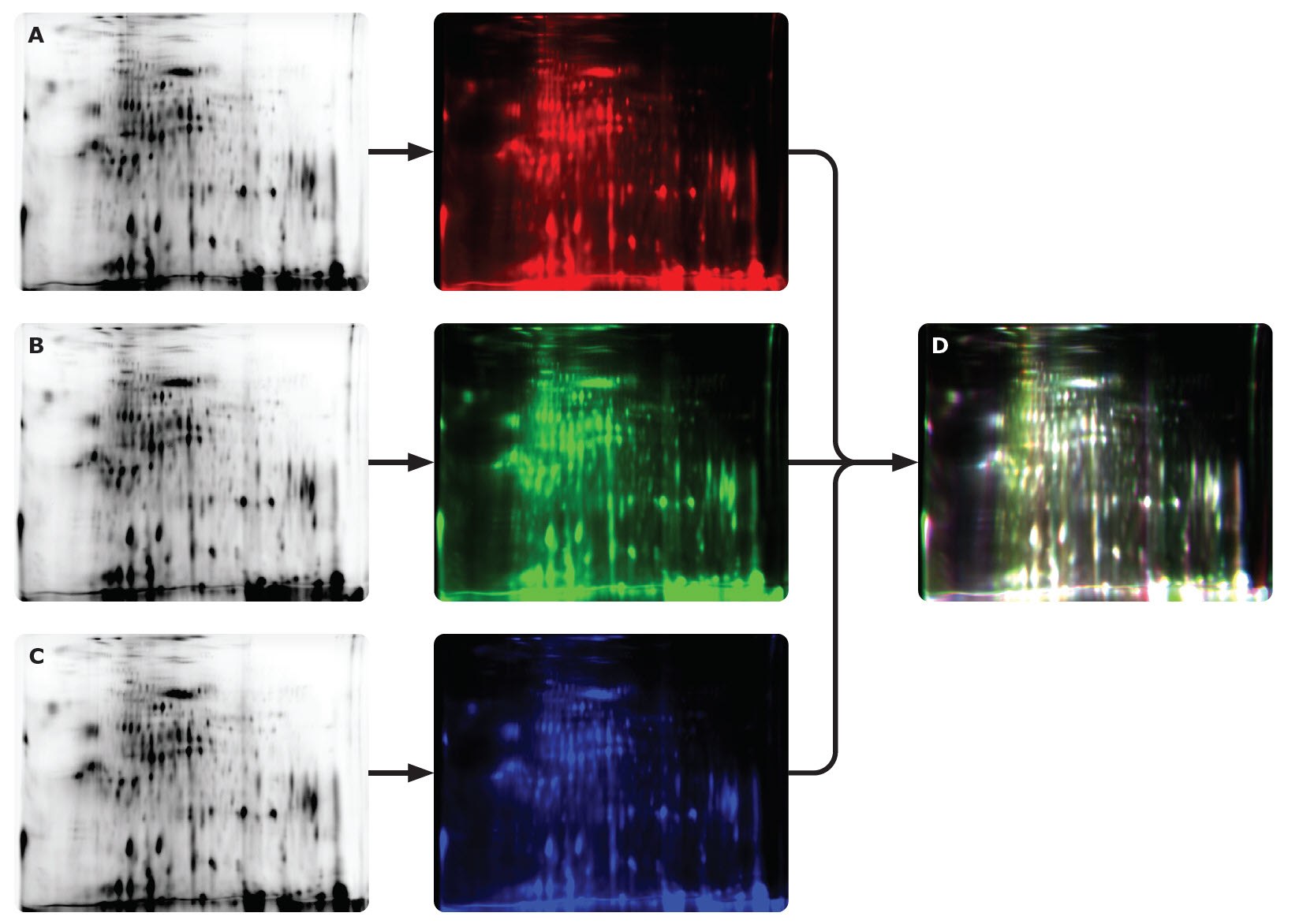
Figure 10.0.75 μg of Cy5-labeled CHO HCP antigen from a commercial source was separated by 2D gel electrophoresis and analyzed on the Auto2D® system using a IEF Chip pH 3-10NL and PAGE Chip 12.5%. The same sample was measured a total of three times (A-C). White spots (D) show overlap of results. The data suggest high reproducibility of two-dimensional gel electrophoresis using the Auto2D® system.
Auto2D® System for Antigen Profiling
Immunization with HCP antigen is required to obtain polyclonal antibody pools for ELISA and other immunoassays. HCP antigen is also used as a calibration standard for detection and quantitation. Process-specific HCP antigens are generated using non-transfected null cell cultures. These antigens must be characterized to show the pattern of HCPs, confirm the presence of a broad spectrum of proteins, and demonstrate that HCP antigens from null cultures are representative of those in production cultures. Japanese, European, and U.S. Pharmacopoeia advise the use of SDS-PAGE or 2-D gel electrophoresis for antigen characterization and profiling. U.S. Pharmacopoeia also suggests the use of 2-D gel electrophoresis as a complementary method for residual HCP monitoring.

Figure 11.A mixture of Cy3-labeled unpurified CHO HCP antigen and Cy5-labeled Protein A-purified CHO HCP antigen were separated and analyzed by two-dimensional difference gel electrophoresis (2D-DIGE) using the Auto2D® system (A-B). Red spots in the merged data (C) represent host cell proteins which tend to remain even after Protein A purification. These data demonstrate the use of the Auto2D® system for profiling remaining host cell protein components post-purification.
Auto2D® System for Regulatory Compliance
The Auto2D® system helps you meet compliance with regulatory requirements for HCP analysis in biopharmaceutical manufacturing. This fully automated system eliminates day-to-day and inter-operator variability for reliable results in less than 2 hours. Easy to implement into bioprocess workflows, the Auto2D® system reduces lab downtime associated with production changes. There’s no need to outsource – protect your intellectual property using in-house resources for HCP analysis. For additional products and resources, please visit our Protein Electrophoresis and Western Blotting hub page.
TotalLab Software Enables Enhanced 2-DE with the Auto2D® 2-D Gel Electrophoresis Device
With low antibody requirements and high separation capabilities, the Auto2D® system significantly reduces the amount of time spent during sample loading, isoelectric focusing, equilibration, and SDS-PAGE. This efficiency makes the Auto2D® device unique compared to other semi-automated 2-DE systems on the market. Expanding on many of the benefits of the Auto2D® device, our collaboration with TotalLab and the coupling of their SameSpots and SpotMap software in the Auto2D® downstream workflow further enhances the previously mentioned benefits. Requiring minimal parameter setting adjustments, TotalLab software reliably demonstrates high reproducibility of spot detection when coupled with the Auto2D® device.
TotalLab Software Offers Automatic Spot Detection and Quantification
Enhanced automation and high reproducibility are achieved with the combination of the Auto2D® device and TotalLab software which improves the reproducibility and speed of 2DE and subsequent Western blot analyses. Using DIGE as the 2-DE detection method, the data below suggests that spot detection via the SameSpots software is readily achieved with samples run on gels from the fully automated Auto2D® device. Sample data is provided from gel images with spot detection results from the SameSpots software, Ver. 5.1.0.0.
The experimental materials for the data analyses include the use of extracted proteins from two types of dry yeast (Yeast A and Yeast B) using CelLytic™ Y Cell Lysis Reagent (C4482) and our Protein-Concentration Kit (2102-M). Protein was subsequently quantified with Brandford reagent (B6916) and labeled with Cy3-NHS ester or Cy5-NHS ester. Protein samples were separated on the Auto2D® device using IEF Chip pH3-10NL and 10.0% PAGE Chip while images were collected using the gel documentation system. Gels images were analyzed using the “Multiple Stains” method according to the recommended workflow analysis in the SameSpots software.
Auto2D® gel images with spot detection results from TotalLab SameSpots software, Ver. 5.1.0.0
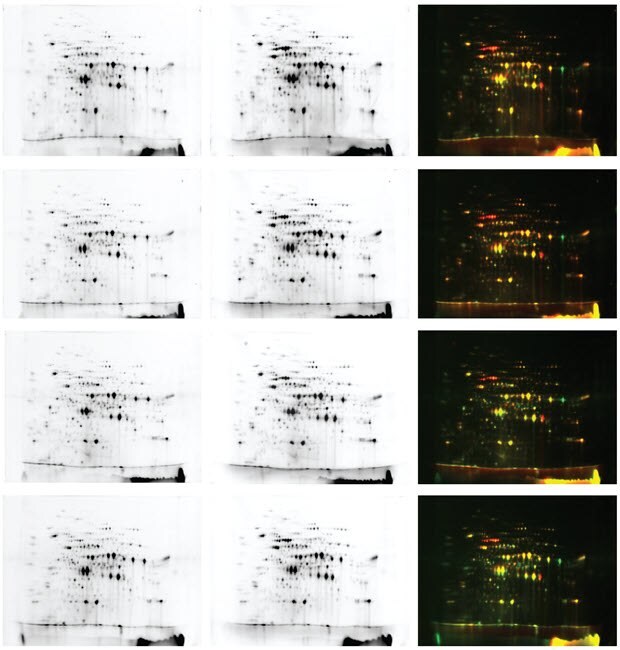
Figure 12.The 4 sets of data for yeast extract sample data sets obtained by DIGE suggests high reproducibility from the Auto2D® device.

Figure 13.Subsequent analysis using the SameSpots software of the gels from figure 12 using the automatic alignment feature for spot matching without manual intervention (cropping/rotation/manual alignment) suggests robust and consistent spot detection.
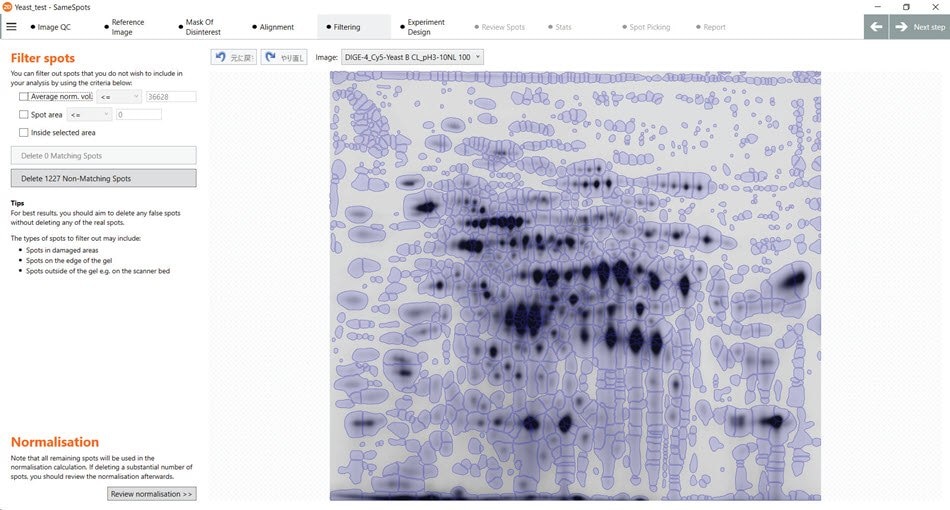
Figure 14.Numerous spots detected by the SameSpots software with only minimal manual operations necessary.
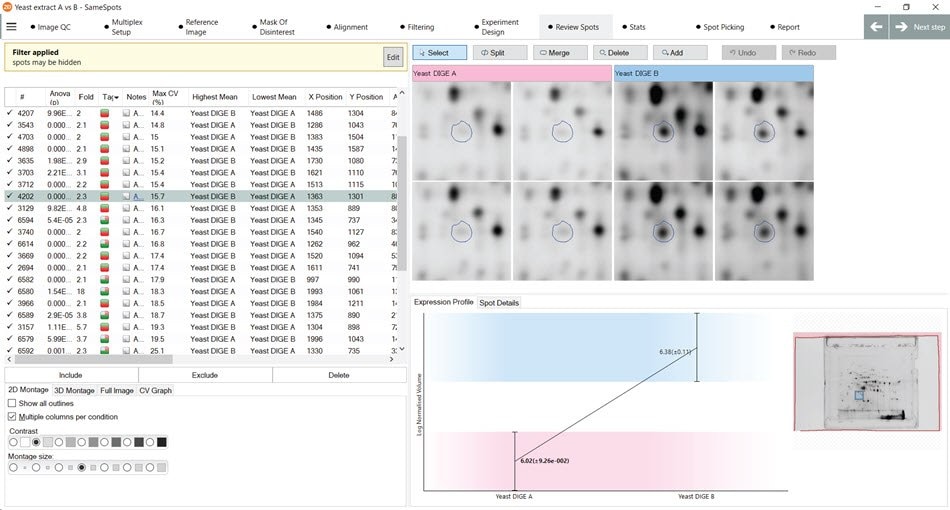
Figure 15.Demonstration of the “Quick Tags” feature in the SameSpots software that are used to identify spots with a user-configurable fold change in expression.

Figure 16.Principal component analysis suggests strong correlation between proteins that were upregulated in the Yeast B vs the Yeast A strain.
Spot Detection Analysis of Auto2D® Gels Using TotalLab SpotMap Software Ver: 5.1.003
Alignment of spots between total protein detection on a gel and the corresponding Western Blot data is often challenging as the spot detection result is inconsistent with variable intensity for each spot. With the SpotMap software, alignment is easily achieved by the auto-align and copy alignment vectors from an aligned image functionality as highlighted with the HCP coverage assay sample data below.
HCP Coverage Assay Using the Auto2D® System and SpotMap Software
The experimental materials for the HCP coverage data analyses include the use of CHO HCP protein samples that were concentrated with our Protein-Concentration Kit (2102-M) and quantified with Bradford reagent (B6916). A fraction of the concentrated protein was labeled with Cy5-NHS ester. Approximately 2 µg of the Cy5-NHS-labeled sample and 8 µg of non-labeled sample were separated on the Auto2D® system using IEF Chip pH3-10NL, 10.0% PAGE Chip, and the gel was imaged using the gel documentation system. Proteins were subsequently transferred onto a membrane using the Immobilon®-FL (IPFL00010) by fast transfer system.
Two different anti-HCP antibodies were used for the Western blot immunodetection. HCP coverage was calculated for the gel image and Western blot image using the SpotMap software. Images were imported, and the total protein image was aligned on the membrane to the total protein image on the gel. The Western blot image was aligned to the total protein image on the gel by copying the alignment vectors. Spots were detected and assigned as either present or absent.

Figure 17.HCP coverage test with Anti-HCP antibody A. Total protein data obtained from the gel (pre-labelling, left), Western blot data with Anti-HCP antibody A (right). SpotMap version number: 5.1.003.
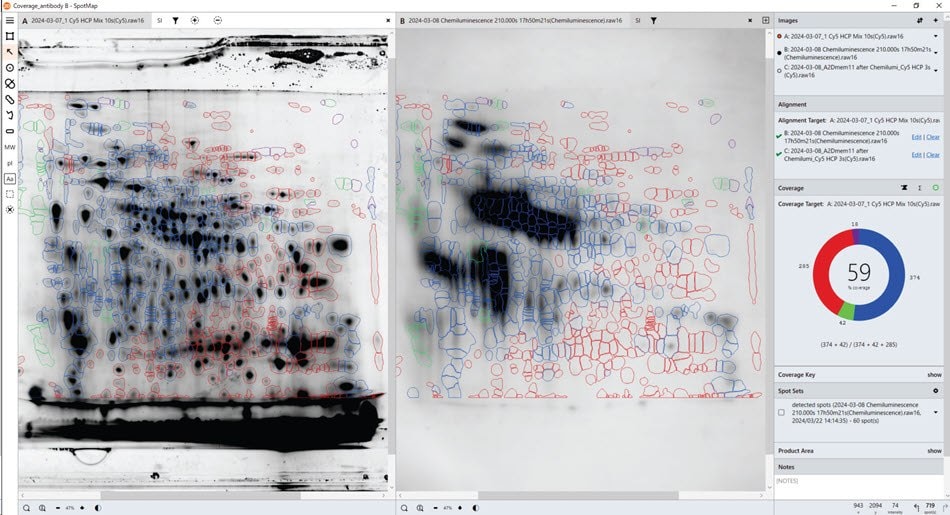
Figure 18.HCP coverage test with Anti-HCP antibody B. Total protein data obtained from the gel (pre-labelling, left), Western blot data with Anti-HCP antibody B (right). SpotMap version number: 5.1.003.
Compared with conventional methods, the required parameter setting adjustments were minimal and it was easy to obtain a reliable coverage percent result due to the high reproducibility of samples run on the Auto2D® device. The anti-HCP antibody coverage score was obtained in as little as 1 hour vs 12 hours using other 2D analysis software.
TotalLab Software Enhances 2-DE and Downstream Sample Analyses
The TotalLab SameSpots software automatically detects spots with high reproducibility on Auto2D® gels with no parameter settings required in advance. By combining the Auto2D® device and SameSpots software, most of the workflow steps can be automated except for image capture. The TotalLab SpotMap software can efficiently detect spots on Auto2D® gels and transfer membrane as shown in the data above, which is suitable for HCP coverage tests.
Related Products
References
To continue reading please sign in or create an account.
Don't Have An Account?